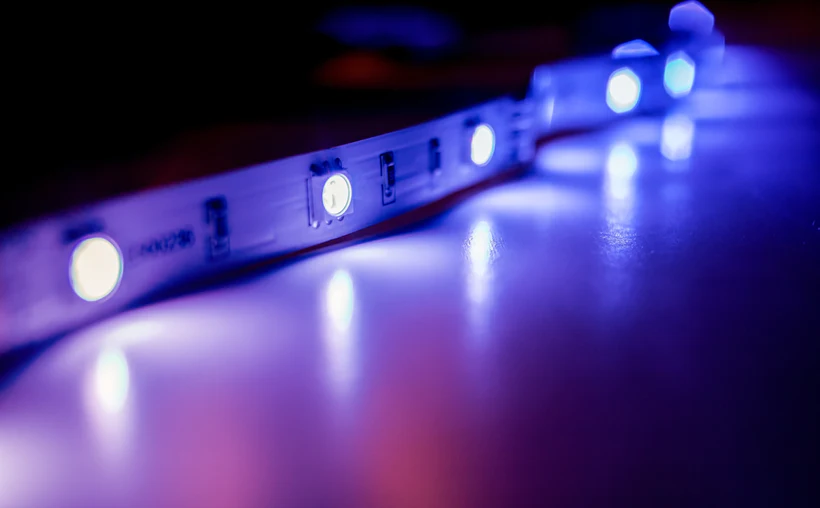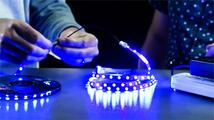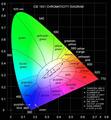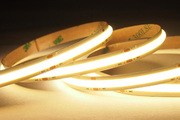5 ways to install LED light strips

The LED light strip refers to assembling LEDs on a strip-shaped FPC (flexible circuit board) or PCB hard board. It is named because its shape is like a strip. Because of its long service life (generally normal life span is 80,000 to 100,000 hours), it is also very energy-saving and environmentally friendly, and it has gradually emerged in various decoration industries.
LED light strip classification
LED light strips are generally divided into flexible LED light strips and LED hard light strips, but they also generally include old-fashioned light strips that use wires to connect LEDs, such as flat three-wire 4.3W/meter, flat four-wire 6.48W/meter, and flat five-wire 8.64W/meter light strip, etc.
1. The flexible LED light strip uses FPC as an assembly circuit board and SMD LEDs for assembly, so that the thickness of the product is only the thickness of a coin and does not take up space; the common specifications are 30cm long with 18 LEDs, 24 LEDs, and 50cm long 15 LEDs, 24 LEDs, 30 LEDs, etc. There are also 60cm, 80cm, etc. Different users have different specifications. And it can be cut or extended at will without affecting the brightness. The FPC material is soft and can be bent, folded, rolled, and moved and expanded in three-dimensional space without breaking. It is suitable for use in irregular places and places with small spaces, and because it can be bent and rolled arbitrarily, it is suitable for any combination of various patterns in advertising decoration.
2. LED hard light strips are assembled with PCB hard boards as circuit boards. LEDs can be assembled with SMD LEDs or with in-line LEDs. Different components are used depending on the needs. The advantage of hard light strips is that they are easier to fix and are more convenient to process and install; the disadvantage is that they cannot be bent at will and are not suitable for irregular places. Hard light strips use SMD LEDs with 18 LEDs, 24 LEDs, 30 LEDs, 36 LEDs, 40 LEDs, etc.; those with direct plug-in LEDs include 18 LEDs, 24 LEDs, 36 LEDs, and 48 LEDs. There are different specifications, including front and side ones. The ones that emit light from the side are also called Great Wall light bars.
LED light strip features
1. Soft and can be curled at will.
2. Can be cut and extended. 3. The light bulb and passage are completely covered in flexible plastic, with good insulation and waterproof properties, and are safe to use.
4. Strong weather resistance.
5. Not easy to break and have long service life.
6. Easy to create graphics, text and other shapes; it has been widely used in buildings, bridges, roads, gardens, courtyards, floors, ceilings, furniture, buses, lakes, underwater, posters, pink signs, signs, etc. Whitewash and illuminate.
LED light strip installation environment
When LED light strips are used outdoors, they will be corroded by rain and ultraviolet rays. If 3M glue is used to fix them, the 3M adhesive will decrease over time and cause the LED light strips to fall off. Therefore, outdoor LED flexible light strips are often installed using The way the card slot is fixed. Where cutting and connection are required, the method is the same as for indoor installation, except that additional waterproof glue is required to consolidate the waterproof effect of the connection points.
LED light strip installation and wiring diagram
1) The first light strip wiring method: (welding method)
The first step is to determine whether the installed light strip/LED light strip uses high-voltage electricity or low-voltage electricity (considering the safety of electricity, it is best to choose a low-voltage electrically activated light strip). After selecting a low-voltage LED light strip, you need to First, observe that there are two dots for every three lamp beads on the lamp strip. Just solder the wire to the dots. However, some children's shoes will use high-voltage light strips considering brightness and illumination. If they are high-voltage, use pins to plug them in and connect the plug to the household power supply of 220 volts.
2) The second light strip wiring method: (terminal wiring method)
First, all the lamp beads are mixed and connected in series with a number of resistors. This is a lamp strip that requires 12V DC power supply. Directly connect the two output lines of the 12V DC power supply (either regulated or unregulated) to the positive and negative sides of the lamp strip. Just plug the power plug into the household AC power socket on the negative terminal, or you can use a 12V battery pack to directly drive this kind of light strip.
3) The third light strip wiring method: (driver connection method)
First, a lamp strip with all lamp beads connected in series needs to be equipped with a capacitor-ballasted constant current driver (there is also a better switch-type constant current driver suitable for driving low-voltage lamp strips). Insert the two pins of the driver plug into the cores of the two leads of the light strip according to the correct polarity, and then plug the driver power plug into a household 220-volt AC power socket.
5 ways to install LED light strips
①The four-wire LED light strip has four wires in total, three rows of lights (note that it is not four rows of lights~~), each row is 1 meter and has 24 lights, 24*3=72. Since the power of each lamp bead is 0.05W, the power of the 72-bead LED light strip is: 72*0.05=3.6W.
②The width of the four-wire LED lamp is about 22mm, the thickness is about 8mm, and the weight is about 0.25kg/m (4 meters per kilogram)
③Each LED light strip must be equipped with a special plug (the plug has a transformer); when connecting, the transparent plastic cover must be removed, and the test light must be connected before covering it again. Do not connect directly with the cover, as this can easily cause a short circuit!
④ There is a "scissor" mark on each meter, and you can only cut it at the mark. If you cut it wrongly or off-center, one meter will not light up! Some may be a little off when marking. It is best to carefully look at the position of the mark before cutting, and cut according to the unconnected center. You can see it if you look carefully.
⑤ When installing LED light strips, they are usually placed in the light trough and can be straightened. They can also be fixed with thin ropes or thin wires. If you need to install it externally or vertically, you need to purchase separate clips and tail plugs. The original clip is fully transparent. It is best to put waterproof glass glue on the tail plug and plug after installation, so that the waterproof performance is better.
Precautions when installing LED light strips
① Do not turn on the power to light up the LED light strips before the entire roll of LED light strips is removed from the packaging or piled up;
② When the LED light strip needs to be cut according to the length of the on-site installation, the light strip can only be cut at the place marked with scissors, otherwise one of the units will not light up. Generally, the length of each unit is 1.5-2 meters;
③When connecting the power supply or connecting two light strips in series, first bend the head of the Licai lamp to the left and right so that about 2-3mm of the wires in the light strip are exposed. Use scissors to cut them cleanly without leaving burrs, and then use a male needle to connect them. , to avoid short circuit;
④Only LED colorful light strips with the same specifications and the same voltage can be connected in series, and the total length of the series connection cannot exceed the maximum allowable length;
⑤When LED light strips are connected in series, try to light one section after each connection, so as to promptly find out whether the positive and negative poles are connected incorrectly and whether the light emission direction of each section of light strips is consistent;
⑥ The end of the light strip must be put on a PVC tail plug, and then tied tightly with a clamp tape, and then sealed around the interface with neutral glass glue to ensure safety.
⑦Because LED has unidirectional conductivity, if you use a power cord with an AC-DC converter, you should first conduct a power test after completing the power connection to make sure that the positive and negative poles are connected correctly before putting it into use.





